Why It’s Important To Give Your Dog Choices
This post may contain affiliate links. We may earn money or products from the companies mentioned in this post.
There are many reasons why it’s important to give your dog choices. In this blog post, I’ll discuss them–and how you can allow him to make decisions.
Look at life from a dog’s perspective. Imagine a world in which every decision is made for you.
The smallest decision, such as which cup to drink from, to the largest, such as where to live, would be out of your control.
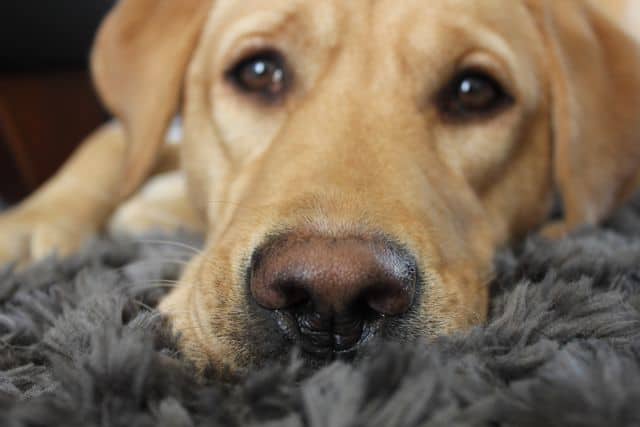
It would be a very sad, depressing existence. You would probably feel trapped and depressed.
In real life, people can make informed choices about the consequences of our actions.
Although dogs don’t always understand what the consequences of their actions will be, they still should be able to make some decisions.
My dogs are given some choices throughout the day. I’ll discuss these in more detail below.
Reasons To Give Your Dog Choices
Dogs who aren’t able to make some choices are often more stressed than those who are permitted to make decisions.
They are usually more anxious than canines who are given some opportunities to do things that they like.
Dogs who aren’t given choices in life feel insignificant and helpless. Dr. Susan Friedman, a psychology professor at Utah State University, is a pioneer of the application of Applied Behavior Analysis (ABA) to captive and companion animals.
She believes that, much like humans, dogs who have freedom of choice over an event’s outcome will be less likely to have behavioral issues or become aggressive.
Giving a dog a choice helps build his confidence, so even skittish dogs benefit.
And decision-making helps independent, confident dogs channel and direct their energy in constructive ways rather than being out-of-control and destructive.
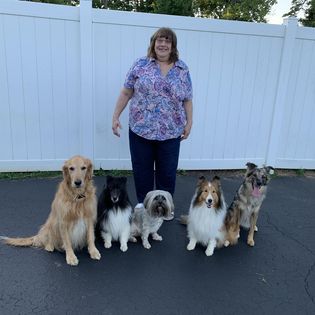
Me with my five confident, happy dogs who are given life choices
Dogs who are given choices in life are generally happier, more relaxed, and emotionally healthier. Control is empowering and beneficial.
And because a dog is then less stressed and more confident overall, he will be better able to handle other stressful situations in his life.
Forcing dogs into situations that they aren’t able to–or don’t want to–handle can lead to many behavioral problems.
For example, forcing two dogs to meet when one doesn’t want to can lead to a fight-or-flight response.
Or making a dog participate in an activity he doesn’t want to, such playing with your friend, can also lead to a fight-flight-or-freeze response, in which your pup gets defensive, flees, or shuts down.
Putting your dog into situations he can’t handle can lead to learned helplessness, in which a dog just turns off and shuts down.
So forcing situations on your dog can make his life miserable and be dangerous.
I always advise my clients not to force any interactions with people or other dogs.
If a dog must become accustomed to another person or dog for some reason–such as a required living arrangement–the dog needs to be slowly conditioned to the other being.
And sometimes the right decision is for the dog to be kept separate from the other dog or person.
Another bonus: giving your dog choices builds a relationship of mutual respect and friendship with you.
What Choices Can a Dog Make?
Dogs are capable of making certain life choices. Of course we need to put some constraints on the choices they make because they can’t foresee some dangers.
We need to make the decisions that concern risks to the dog’s safety. These include decisions that involve traffic, environmental hazards, or other animals or people who may not want to engage with the dog or pose a danger to him.
So you can have your dog run off-leash in self-contained safe space but not in an area where traffic passes through. A dog wouldn’t necessarily understand the danger.
Of course, dogs do best with a routine schedule. But even within a regular schedule, you can allow your pup to make some choices.
So I’ll describe some ways you can have your favorite canine have freedom making choices. And you should also vary some of their choices to make their life even more pleasurable and satisfying.
Of course you love your pup or you wouldn’t be reading this blog post.
You know your dog best. So make a list of what ways you are most comfortable with giving him choices to start with.
Let’s discuss some ways in which you can have your dog make some real-life choices.
Going Inside or Outside
Of course your dog needs to go out to potty. But what if he just feels like hanging out or playing outside?
There are times I feel like going inside when I’m in the yard with my pups but it’s apparent that my dogs want to stay outside and “smell the roses”–or roll in the grass.
So if I’m able, I’ll stay outside a little longer with them. Or run inside briefly, returning to check on them.
They really appreciate the time and love sniffing around outside to determine what other furry creature has passed through.
And even just lying around in the fresh air is a happy experience for them.
Taking a Different Type of Walk
If you always take the same route, your dog may become very bored.
Taking a new, safe route can provide mental and physical stimulation for your pup. The sights and the smells are very intriguing to him.
So, if it’s safe to do so, you can let your pup choose the route sometimes.
Or instead of a normal, paced walk for exercise, your dog may just want to sniff for a while.
After all, dogs have a “nose brain” and sniffing is fun and provides so much information to the dog such as who has been there and what’s ahead. So let your pup lead you on a sniffari.
My dogs love going on a sniffari. It’s fun for them to use their natural senses–and improves the quality of their lives.
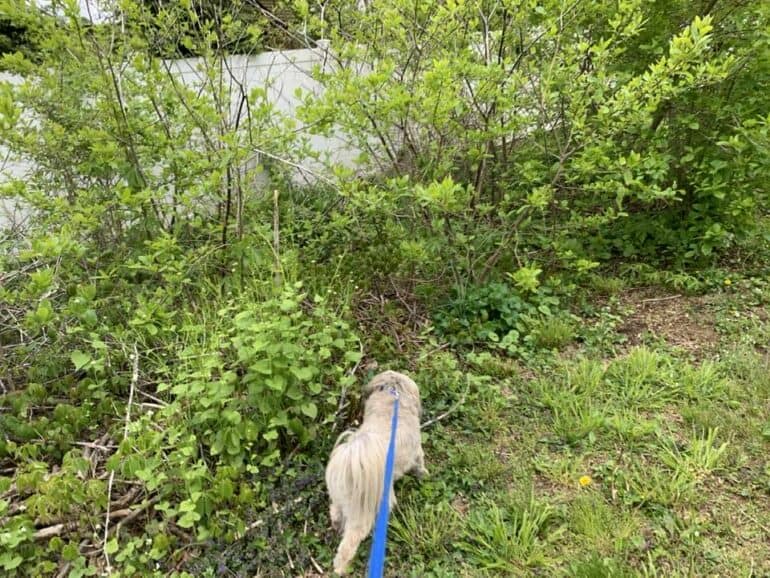
Lhasa Ralphie on a Sniffari
Choosing Whether or Not To Interact
It’s never a good idea to force a dog to interact with a person, animal, or environmental object or situation if he doesn’t want to.
If your dog needs to get used to something or situation, properly socialize him to it. In the meantime, there are good reasons why a dog may not interact.
The person or animal may be unfamiliar or acting strangely. So a dog who is forced to interact may shut down or even become defensive depending on the situation.
This often happens when dogs are forced to greet and interact with each other, such as occurs at dog parks.
Instead, give your dog the choice of moving away if it’s safe to do so. The dog can then choose if he wants to approach.
Give him the opportunity to choose whether or not to interact with people, such as being petted by someone. Let him disengage.
Many dogs will solicit attention and even nudge the person if they want to be petted.
My rescued sheltie Lady used to do that. After she got comfortable with us, she used to come over and nose-bop my leg to solicit attention. It was really cute.
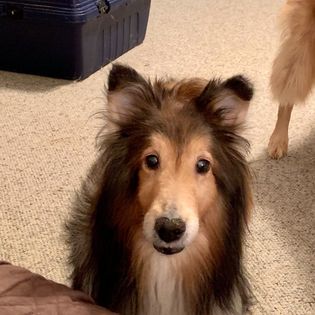
Sheltie Lady soliciting attention
I rewarded it by petting her. It gave her a lot of confidence and improved the quality of her life.
It was really funny when she did it to other people, as she gained confidence.
One time my friend Raymond was over and told me that Lady was nosing his leg. It showed that she trusted him. He thought it was cute too to see this little sheltie confidently solicit attention.
Giving the Dog a Safe Space
Your dog should have a safe space to retreat to when needed. This can be a crate with a bed inside or even a bed in a quiet room he always has access to.
If your pup chooses to retreat, such as from guests, provide the safe space for him to chill out and avoid stressful situations.
And you can then even afterwards block access to the dog by children, adults, or other animals by a gate if needed so that your pup’s peace isn’t interrupted.
Choosing from Multiple Sleeping Areas
You can provide different areas for your dog to rest. This can be beds in different rooms or areas of a room. Or even choosing to sleep on your bed versus a bed on the floor.
I have various beds for my dogs. And they’re allowed on furniture in the family room with throw covers. They move to different spots as they choose throughout the day.

Lhasa Ralphie choosing to be on the sofa
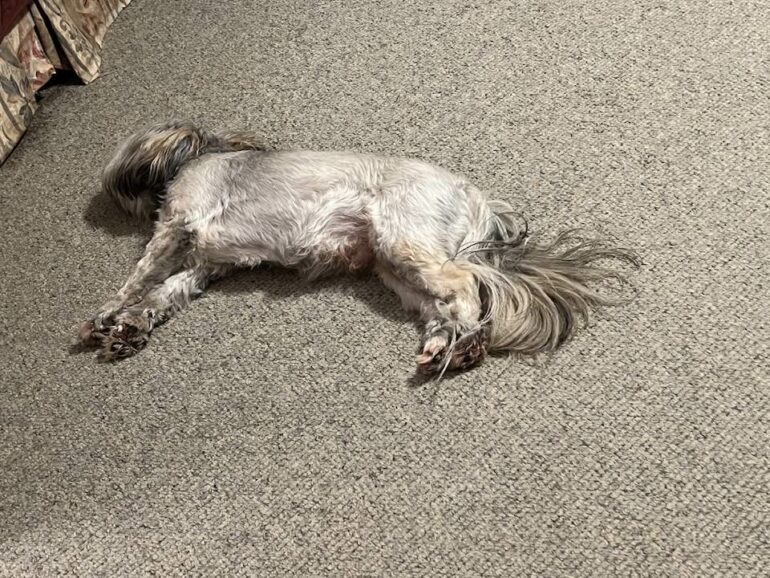
Lhasa Ralphie choosing to lie on the floor
My shih tzu Cuddles usually slept in our bed, which we loved. But sometimes she chose to sleep in the guest room on the bed.
Choosing To Train or Not
This is a tough one for me as a trainer. But sometimes there are reasons why you should let your dog opt out of training. After all, training should enrich your dog’s life and not be a punishment.
Sometimes your pup may just be too tired to train. Or the environment may be too distracting. Or you may be attempting to teach something that’s too difficult.
Figure out why your dog doesn’t feel like training during the session. In these cases, you can let your dog end the session and wander off.
It’s best to try to evaluate whether your dog’s too tired, distracted, or otherwise overwhelmed before even attempting to train.
If you misjudged and your dog needs to end the session, that’s fine. Just try to make sure that your dog isn’t too tired, distracted, or overwhelmed during the next training session.
Train when the pup is mentally and physically rested. And practice in environments that aren’t too distracting. And break the components of what you are attempting to teach into parts that your dog can easily learn.
I teach many advanced behaviors to my dogs. One is retrieving an obedience dumbbell. Instead of overwhelming the dog, I teach the components individually.
I’ve seen some people try to teach everything at once, and their dogs become overwhelmed and just shut down.
The other day, my Aussie mix Millie–who’s one of the most energetic dogs you’d meet–wanted to end our training session. I could tell she was just not as focused as usual. So we ended the session.
Choosing Between Foods and Treats
Sometimes dogs don’t like certain foods or treats, though many will scarf down anything.
If for some reason your dog just doesn’t want to eat a certain meal, you can provide a second option with a different protein source.
Of course you don’t want to create a picky eater, so make sure that your vet agrees that any diet that you provide is nutritionally sound and won’t lead to digestive upsets.
I know some people who are savvy about canine nutrition who believe that pet parents should rotate certain diets on various schedules. It’s best to check with a specialist regarding what you should provide to your specific dog.
You can even put one type of treat or dry kibble in a food-dispensing toy and another type of food or treats in the same type of toy to see which your dog prefers.
As far as treats are concerned, you can test which your dog prefers. Hold a piece of two different types of treat, one in each hand. Let your pup sniff and see which he wants first.
Most dogs love meat, cheese, or fish-type treats over a dry biscuit-type. So you can provide a choice between two treats of the same value to see what your dog truly prefers.
I’ve done this with my dogs. I had a piece of cheese in one hand and a piece of freeze-dried liver in the other. Most quickly scarfed down the meat–and looked at me as if to say, “you needed to ask?”
Choosing Between Toys
Most dogs prefer one type of toy over another.
My shelties Murphy and Gracie love soft frisbees, whereas golden Riley and Aussie mix Millie are obsessed with their Extreme Kong ball. Of course these toys are used only outdoors.
But, if I bring out other toys instead to play with inside, there are definite preferences.
Lhasa Ralphie prefers chewing on and shaking around the unstuffed toys over those that squeak.
But Aussie mix Millie will squeak the squeakers in toys until they die an unceremonious death. Luckily, I’ve pretty much learned to tune it out.
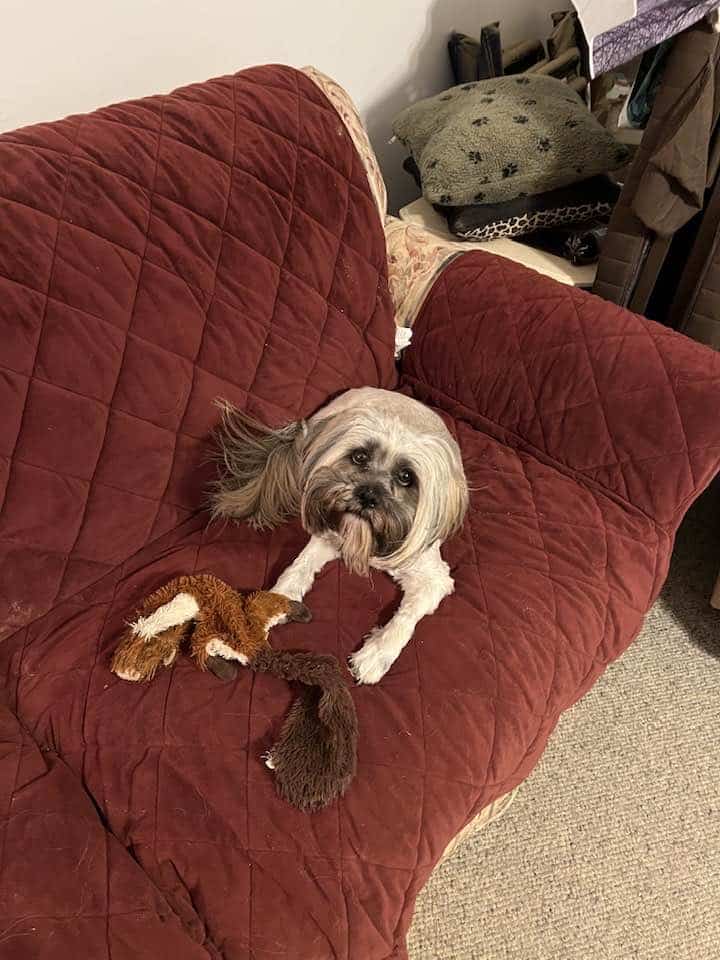
Ralphie with unstuffable toy he chose
So you can provide a rotation of various toys for your dog to select from. And play with him with the one he feels like playing with at that time.
How To Decide What Your Dog Chooses
Of course some actions our dogs make are obvious. They make a beeline to a certain area, treat, or toy. But sometimes you may not know what a dog prefers.
In learning what your dog likes and doesn’t, also look at his body language. A stressed dog may show some or all of the following:
- Tucked tail
- Yawn
- Lip licking
- Panting
- Pacing
- Drooling
- Whale eye (where the whites of the eyes show)
- Trembling
- Moist pads that aren’t temperature-related
- Ears pulled back
Of course, you’ll need to still keep a basic schedule with regard to your dog’s activities. But you can still find ways to help improve your dog’s life by allowing him to have choices sometimes.
You can even add a verbal and physical cue when letting your dog know he has a choice, such as by saying “What do you choose?” And also point to each choice.
Then, you can verbally praise him for his selection. And he gets rewarded by permitting him to select.
For example, you can even point in two different directions on a walk. Or you can put two toys down and point to each at the same time. You get the idea.
FAQs
My dog gets bored on our walks. He seems to want to go on a different path but I thought that means he’s being dominant. What should I do?
You can consider taking him on a route he prefers if it’s safe to do so. He may be showing you that he needs some variety. And dogs aren’t being dominant by seeking variety in their lives.
My dog wants to sleep in my bed. Should I let him?
As long as he doesn’t have behavioral issues such as aggression or resource guarding space or you, it’s fine to do so. It’s really a personal preference–and can be a way of providing choices to your dog.
My dog doesn’t like the toys he has. What should I do?
Try providing different types, giving him two or three at a time to choose from. Try balls, rope toys, soft squeaky toys, unstuffed toys, honking toys, and others. Rotate the selection so that he doesn’t become bored.
Final Thoughts
Providing choices can help enrich your dog’s life. It can also further your bond and make life more fun for you both.
Have you provided any choices to your dog? Please tell us about it in the comments section below.
Save To Pinterest
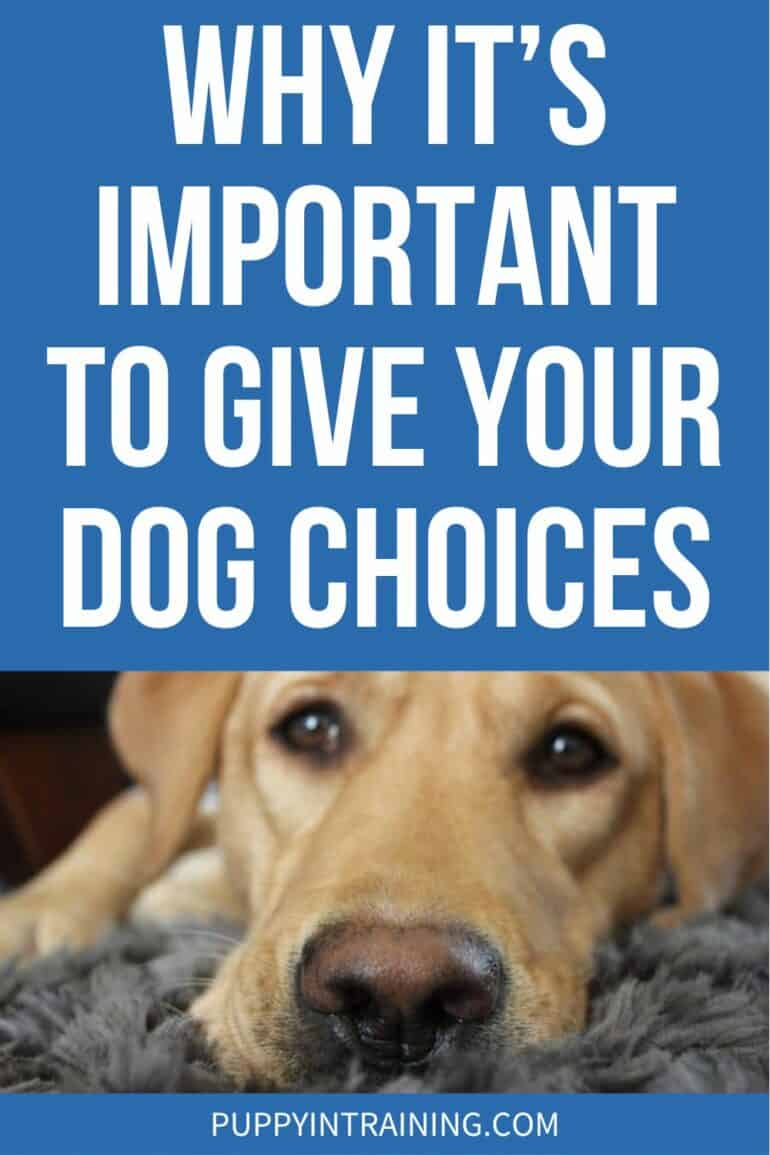
Top Picks For Our Puppies
- BEST DOG CHEW
We Like: Beef Collagen Sticks - All of our pups love to bite, nip, and chew. We love using Collagen Sticks to help divert these unwanted behaviors. - BEST PUPPY TOY
We Like: Calmeroos Puppy Toy w/ Heartbeat and Heat Packs - Perfect for new puppies. Helps ease anxiety in their new home. - BEST DOG TREATS
We Like: Crazy Dog Train-Me Treats - We use these as our high-value treats for our guide dog puppies. - BEST FRESH DOG FOOD
We Like: The Farmer's Dog - A couple months ago we started feeding Raven fresh dog food and she loves it! Get 50% off your first order of The Farmer's Dog.
Check out more of our favorites on our New Puppy Checklist.